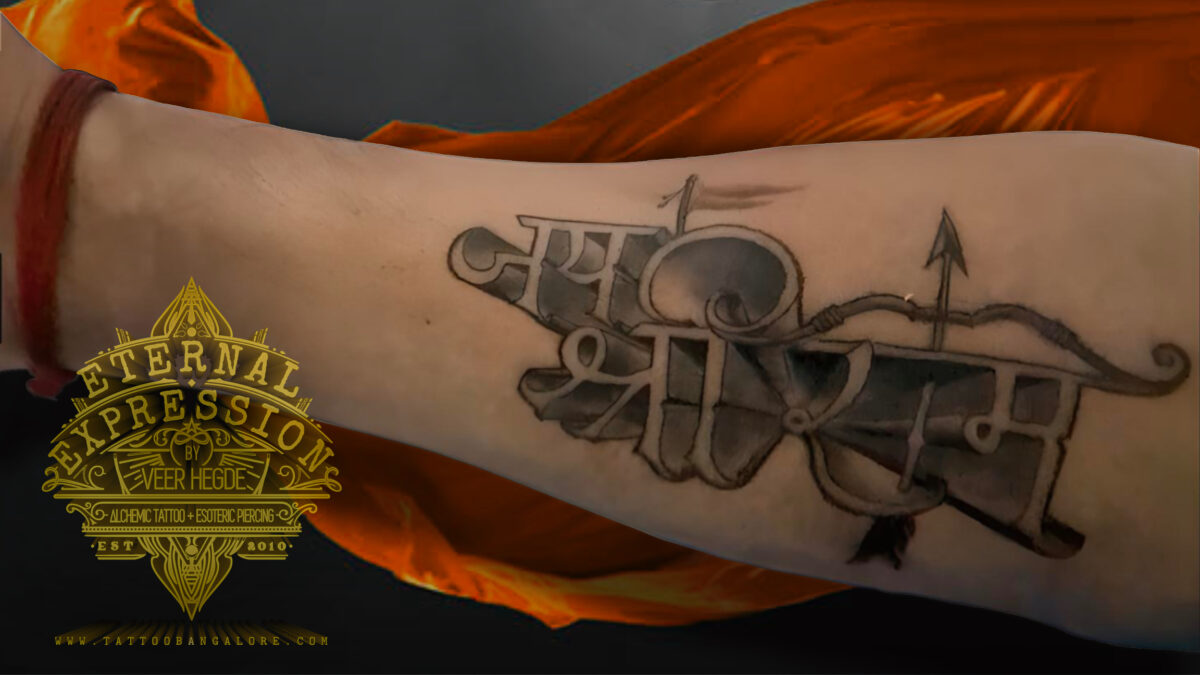
The phrase “Jai Shree Ram” has resonated in the Indian Subcontinent for over 5000 years. Transcending mere words and becoming a powerful symbol of faith, identity, and Sanatani Hindu pride. This article delves into the significance of “Jai Shree Ram” in Indian culture while exploring the popularity of the “Jai Shree Ram tattoo.” We’ll shed light on what this phrase represents to Hindus and Indians, taking into account its historical and cultural context, offering an in-depth look into the profound essence of Lord Rama, and exploring the ancient practice of Ram tattoos within the Ramnami Samaj.
“Jai Shree Ram” is an expression in various Indic languages (Sanskrit, Hindi, Kannada, Telugu, Tamil, Gujarati, Bhojpuri, etc.), signifying “Glory to Lord Rama” or “Victory to Lord Rama.” This proclamation holds deep historical and cultural significance. It’s used as an informal greeting, a symbol of unwavering Hindu faith, and to express a large spectrum of faith-centred emotions.
Historical and Cultural Roots: “Jai Shree Ram” draws its roots from the epic tale of the Ramayana, where Lord Rama, a revered deity in Hinduism, embodies the values of righteousness, devotion, and the victory of good over evil. This chant represents the age-old cultural and spiritual heritage that has shaped India’s identity.
Lord Rama, often referred to simply as “Rama” or “Ram”, holds a central and revered position in Hinduism. He is considered an avatar of Lord Vishnu, the preserver in the Hindu trinity. He is known for his exemplary life and divine qualities.
Sage Valmiki, in the Yuddha Kanda of the Ramayana, describes the attributes of “Rama Rajyam”:
While Rama was ruling the kingdom, there were no widows to lament, no danger from wild animals, and no fear of diseases.
Every creature felt pleased. Everyone was intent on virtue. Turning their eyes towards Rama alone, the creatures did not kill one another.
While Rama was ruling the kingdom, people survived for thousands of years, with thousands of their progeny, all free of illness and grief.
While Rama ruled the kingdom, the talks of the people centred around Rama, Rama and Rama. The world became Rama’s world.
The trees there were bearing flowers and fruits regularly, without any injury by pests and insects. The clouds were raining in time and the wind was delightful to the touch.
All the people were endowed with excellent characteristics. All were engaged in virtue.
Many societies had such a version of utopia and this is the Indian version of it.
The “Jai Shree Ram tattoo“, a relatively recent addition to Indian culture, has garnered immense popularity, particularly among Proud Sanatani Hindus. Although getting Ram’s name inked is an Ancient Practice within the Ramnami Samaj. The Jai Shree Ram Tattoo is relevant in the Eternal Land of the Hindus, whose culture and ideals are deeply influenced by Lord Ram. This tattoo usually features the phrase “Jai Shree Ram”, artistically inked on the forearm, arm or back, symbolizing more than mere body art. From an Indian’s perspective, it serves as a medallion, a testament to faith, identity, and belief in the Lord.
Who gets full body tattoos of only the name of the Lord Rama inked all over their body and face?
The Ramnami Samaj, a religious sect that emerged centuries ago, holds a unique practice of permanently tattooing the name of Lord Rama on their bodies as a symbol of devotion. This tradition reflects an unwavering commitment to the deity and a testament to their faith. This practice exemplifies the freedom of religious expression and the commitment to preserving and passing on cultural traditions.
“Jai Shree Ram” isn’t just a chant; it is more a symbol of faith, culture, and values that have deeply influenced India for centuries. The “Jai Shree Ram” tattoo encapsulates these sentiments, highlighting individual freedom, cultural pride, and the spirit of inclusivity. In a diverse and ever-evolving India, it represents an ongoing commitment to upholding the principles of “Ram Rajya,” with Lord Rama as the eternal source of inspiration and guidance, striving for a society based on justice, respect, and non-coercion. Sage Valmiki’s vision of “Rama Rajyam” reflects a utopian ideal that continues to inspire and guide Indian society towards prosperity, dharma, and happiness. Get your custom Jai Shree Ram Tattoo by Veer Hegde at One of India’s Best Tattoo Studios in Bangalore – Eternal Expression!